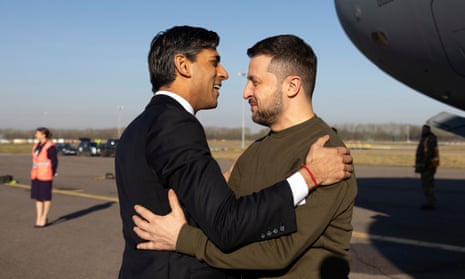The British offer to train Ukrainian pilots on modern Nato fighter jets is a carefully couched hint to the rest of Nato that at some point it may have to provide modern jets to help Ukraine defend its airspace from the Russian air force.
The offer of Nato jets to Ukraine briefly surfaced as an idea after the controversy over the provision of tanks was settled with as many as 150 tanks to be offered within the next year.
But the jets proposal looked like a red line too far with a firm no from the US president, Joe Biden, and an even firmer rejection by the German chancellor, Olaf Scholz.
But as the past year has shown, initial rejections of forms of aid to Ukraine have been frequently overturned only months later. By offering to train Ukrainian pilots Rishi Sunak is at least setting down a marker. In welcoming the Ukrainian president, Volodymyr Zelenskiy’s, visit to the UK on Wednesday, Sunak was careful to couch the proposal as part of a long-term plan to ensure that in future Ukraine is master of its own skies.
Sunak said: “The training will ensure pilots are able to fly sophisticated Nato-standard fighter jets in the future. As part of that long-term capability investment, the UK will work with Ukraine and international allies to coordinate collective support to meet Ukraine’s defensive needs.”
He will also offer to begin an immediate training programme for marines.
After Zelensky in his speech made a direct appeal to provide fighter jets and Boris Johnson backed the move by saying Britain has 100 typhoon jets available, Downing Street was on the defensive.
A week ago No 10 said it was not practical to send British jets since they were too sophisticated, and it would take years for Ukrainian pilots to be trained. But at Downing Street briefing the position altered slightly with a spokesman saying the defence secretary Ben Wallace would look at what jets could be provided but the emphasis is on increasing Ukraine’s capability in the short term. The UK is short of pilots itself and favours the F-35s being sent.
Meanwhile, Scholz, in an interview on Sunday with Tagesspiegel, doubled down on his refusal to countenance jets saying: “The question of combat aircraft does not arise at all. I can only advise against entering into a constant competition to outbid each other when it comes to weapons systems.” Speaking to the Bundestag on Wednesday he defended his strategy saying: “We preserve and strengthen this cohesion by first preparing decisions confidentially, and only then communicating them.
“What harms our unity is a public competition to outdo each other along the lines of: ‘battle tanks, submarines, aircraft – who is asking for more?’”
Ukraine renewed its request for the fighter aircraft almost immediately after Berlin and Washington announced the tanks. Ukraine’s ambassador to Germany, Oleksiy Makeyev, piled on the pressure, saying: “Every day that we discuss and debate internally or negotiate the rules of engagement with partners, Ukrainian soldiers and Ukrainian civilians are dying.”
On 30 January – the day Biden said he was not in favour of sending jets, the French president, Emmanuel Macron, seemed more open to the idea, saying it depended on the circumstances. His conditions included ensuring the jets did not touch Russian airspace and the provision did not weaken the French air defences.
The Dutch foreign minister, Wopke Hoekstra, told lawmakers earlier this month there were “no taboos” about sending the warplanes. Mark Rutte, the Dutch prime minister, echoed his words, but added: “It would be a very big next step.”
after newsletter promotion
Greg Bagwell, a former senior RAF commander and adviser to the defence thinktank Rusi, said: “The UK has synthetic training facilities, which can be used to train on modern tactics and weapon employment. Learning to fly an aircraft is a relatively simple transition. Learning how to use the systems to maximum effect is the key part and transferable to most modern types.”
Regardless of whether Nato supplied jets, the UK argues that Ukraine had a small air force of Soviet-standard jets at the start of the war, amounting to about 120 combat-capable aircraft, according to the IISS thinktank. That number has dwindled as the war has gone on although, remarkably, given the number of Russian aircraft and air defences, experts say Ukraine retains a limited air capability.
Justin Bronk, air specialist at Rusi, said: “The announcement doesn’t mean training on Typhoon, or that the UK will soon supply jets. Training Nato tactics, cockpit procedures in (non-type specific) simulators will speed up later conversation to F-16/Gripen etc, and add tactical value with current types.”
A broader Rusi report on the state of the war found Russian fighters had remained highly effective and lethal against Ukrainian aircraft near the frontlines throughout the war, especially the Su-35S with the R-77-1 long-range missile and, in recent months, the Mig-31BM with the R-37 very long-range missile.
It warned: “The west must avoid complacency about the need to urgently bolster Ukrainian air defence capacity. It is purely thanks to its failure to destroy Ukraine’s mobile [surface-to-air missile systems] that Russia remains unable to effectively employ the potentially heavy and efficient aerial firepower of its fixed-wing bomber and multi-role fighter fleets to bombard Ukrainian strategic targets and frontline positions from medium altitude, as it did in Syria.”
